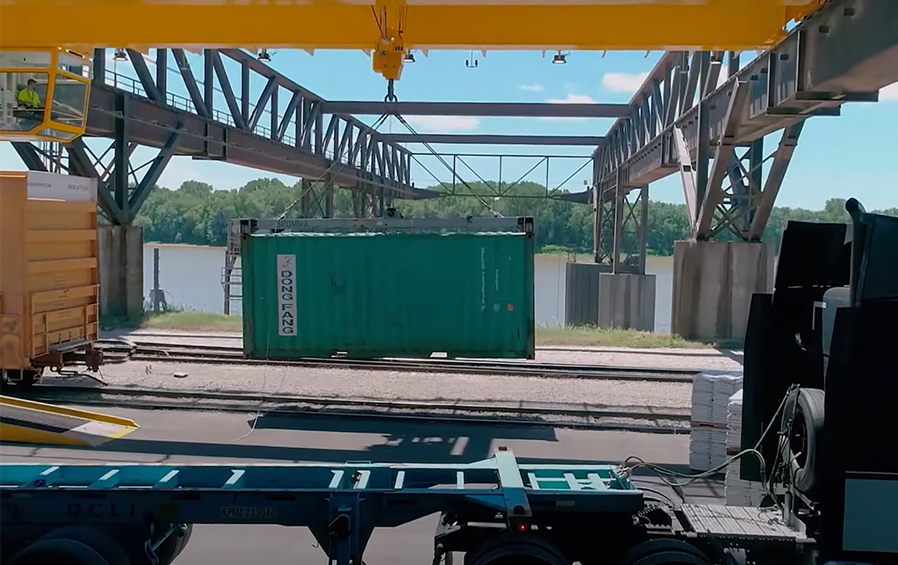The Ports of Indiana Commission approved a statewide container initiative June 13 that supports the development of multiple international container terminals on the Ohio River, Lake Michigan and at strategic inland locations.
The state’s ports currently do not handle container shipments, but the so-called Indiana Container Initiative is designed to increase efforts to pursue the development of international container facilities, both within Indiana’s ports and other locations throughout the state.
“Containerized freight represents a critical component of our state’s international trade and a new frontier for expanding our ports,” Ports of Indiana Commission Chairman Micah Vincent said. “This resolution clearly states our vision and commitment to develop new container facilities that will increase the value of our ports and provide critical shipping connections for Indiana businesses.”
Additionally, the resolution authorizes and directs Ports of Indiana to pursue regulatory approvals necessary for establishing container facilities in the state; make investments and seek out funding sources, including governmental assistance, grants and public/private investments; remove bureaucratic impediments for developing and operating container facilities; and engage in partnerships, trade missions, international agreements and collaborations to establish shipping opportunities.
“Containers are a high-value and fast-growing cargo for ports around the world, and we see the Indiana Container Initiative as a key driver for elevating Indiana’s role as a hub for global trade,” Ports of Indiana CEO Jody Peacock said. “Establishing new container facilities at the ‘Crossroads of America’ can create both economic and public benefits by reducing shipping costs, creating access to world markets and establishing green shipping corridors that decarbonize supply chains.”
Container Shipping Conference
Gov. Eric Holcomb kicked off the state’s first Indiana Container Shipping Conference and Intermodal Rail Tour on June 17. The conference was an opportunity for business, agriculture and transportation leaders to discuss ways to develop new container ports, grow agriculture exports and expand global trade. The Ports of Indiana, Indiana Soybean Alliance (ISA) and Indiana Corn Marketing Council (ICMC) teamed up to host the conference.
“I commend Indiana’s statewide agricultural sector and port leaders for convening this important discussion about growing Indiana’s global trade by expanding our international container shipping opportunities,” Holcomb said. “Our state has a proud ag-based heritage and an equally exciting future, led by specialized soybeans, corn and hardwood products that are coveted throughout world markets. Leveraging all our port, rail and transportation resources to expand our container shipping connections will strengthen our economy and create even more opportunities for Hoosier farmers, businesses and families.”
The conference included a tour of Indiana Rail Road’s Senate Avenue Intermodal Yard and featured speakers from International Feed, S&P Global, POET Bioprocessing of Cloverdale, Ind., Pence Group, Cole Hardwood, Cargo Services, Indiana Rail Road, ISA, ICMC and Ports of Indiana.
“Improving our infrastructure to support local container terminals can provide Hoosier farmers with access to overseas customers,” ISA and ICMC CEO Courtney Kingery said. “Indiana corn and soybean farmers produce premium, value-added products but often lack easy access to international container facilities that offer efficient shipments of identity-preserved commodities to world markets.”
The hosting trade groups noted in a news release that development of shipping containers with standard dimensions supports efficient transport of a variety of goods in truck-sized containers. Standard containers are generally 8 feet wide, 8.5 feet tall and 20 or 40 feet long, with larger sizes available. Global standardization allows ocean vessels to stack and carry more than 20,000 containers per voyage to multiple countries around the world.
“Container shipping represents a major new venture for Indiana’s ports,” Peacock said. “We don’t handle containers today due to regulatory and market challenges, but containers represent the highest-valued and fastest-growing cargo for ports around the world. By working with our state agriculture partners and many others, we hope to develop new container facilities that will allow Indiana to better connect with the global economy.”
The volume of corn, soybeans or farm commodities—as well as other raw commodities—that leave Indiana in containers is relatively small, said Ed Ebert, senior director for market development for ISA and ICMC. However, with the correct infrastructure in place, Ebert believes Indiana could tap into already existing shipping routes.
“Shipping from Asia and China can play a significant role,” Ebert said. “China is a key player in the global container network. Containers with consumer goods leave major ports in China as well as Japan, South Korea and Southeast Asia destined for the largest consumer goods market in the world—the United States. When these containers are offloaded and emptied, they can ideally be loaded with U.S. soybeans to get hauled back to China and Asia.”
Kingery recently traveled to meet overseas buyers and identified in-demand Indiana agricultural products as including specialty soybeans, such as high oleic, non-genetically modified or food grade soybeans; specialty corn, like non-genetically modified or waxy corn; soybean and corn co-products, including distillers’ dried grain or ethanol; meat and poultry, such as eggs, turkey, duck and pork; and Indiana hardwoods. He said the annual market potential for containerized exports could be up to 11,600 containers worth $165 million in product value between soybean and corn commodities and co-products alone.



